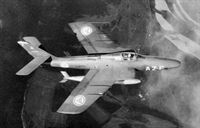Фотографии
-
Two generations of photo-reconnaissance specialists together in January 1969 - nearest the camera is RF-84F serial 52-8714, coded AZ-F, beside Northrop RF-5A serial 68-9105, AZ-M. The much more capable twin-engined RF-5A took over the RF-84F’s role completely when the last RNoAF Thunderflash was retired in June 1970.
Самолёты на фотографии: Northrop F-5A Freedom Fighter - США - 1963Republic RF-84F Thunderflash - США - 1952
-
RF-84E-26-RE serial 51-17053, coded AZ-G, in the type’s final colour scheme in RNoAF service, comprising camouflage upper surfaces, white codes and Aluminium-painted undersides. This aircraft is currently on display at the Norwegian Armed Forces Aircraft Collection at Gardermoen, north of Oslo.
Самолёты на фотографии: Republic RF-84F Thunderflash - США - 1952
-
Republic RF-84F-36-RE serial 52-8747, coded T3-L, was one of a batch of 50 built at the company’s factory at Farmingdale, New York, and is seen here in its original RNoAF bare-metal scheme. On the fuselage below the windscreen is a cartoon motif of Donald Duck on a magic carpet with a camera in his hands, denoting the unit’s photo-recce role.
Самолёты на фотографии: Republic RF-84F Thunderflash - США - 1952
-
A line-up of Thunderflashes in the early 1960s, after No 717 Sqn’s adoption of “AZ” codes. The RNoAF constitued an important part of Nato’s ability to monitor its northern flank, Norway and the Soviet Union sharing a 196km (122-mile) border between Norway’s Sor-Varanger municipality and the USSR’s Murmansk Oblast.
Самолёты на фотографии: Republic RF-84F Thunderflash - США - 1952
-
Thunderflash serial 52-7319, coded AZ-C, was originally operated by France’s Armee de I’Air, and was acquired by the RNoAF in October 1963. It served with No 717 Sqn until November 1969, when it was withdrawn from service. Four former RNoAF examples survive today as museum exhibits in Norway, plus one nose section.
Самолёты на фотографии: Republic RF-84F Thunderflash - США - 1952
-
A pair of Luftforsvaret (Royal Norwegian Air Force - RNoAF) RF-84Fs await their next photographic reconnaissance sortie in the mid-1960s.
Самолёты на фотографии: Republic RF-84F Thunderflash - США - 1952
-
Kaptein Knut Lande, a self-portrait of whom is seen in “the office”, started his flying career in 1964 and went on to serve as a photo-reconnaissance fighter pilot, flying instructor and test pilot during his career with the RNoAF.
Самолёты на фотографии: Republic RF-84F Thunderflash - США - 1952
-
The author poses for a photograph beside a Thunderflash after a flight. He has been an active civil aerobatic pilot and flying instructor since 1970, and has written textbooks and training programmes for aerobatic pilots and instructors, as well as published numerous articles in aviation periodicals.
Самолёты на фотографии: Republic RF-84F Thunderflash - США - 1952
-
The RF-84F was a dedicated photo-reconnaissance development of Republic’s F-84F Thunderstreak, the latter’s nose air intake being replaced with wing-root intakes in order to free the nose for a comprehensive suite of photographic equipment. The resulting drop in performance was deemed acceptable for the photo-recce role.
Самолёты на фотографии: Republic RF-84F Thunderflash - США - 1952
-
Four RF-84Fs of No 717 Sqn (PR) gleam in their bare-metal schemes in contrast to the characteristically steep-sided fjord in the background. As with most early turbojet-powered fighters, range was an issue, and the Thunderflash always carried a pair of wing-root-mounted 450 US gal (1,700lit) external fuel tanks for operations.
Самолёты на фотографии: Republic RF-84F Thunderflash - США - 1952
-
Wearing squadron code T3-A, a Thunderflash undergoes maintenance in the late 1950s. Unique to the F-84F and RF-84F, note the articulation of the canopy, which is mounted on a pair of hydraulic rams and a lever arm, allowing it to pivot up and backwards behind the cockpit. Of typical Republic design, the RF-84F was built to be exceptionally robust, and was stressed to withstand some 9g.
Самолёты на фотографии: Republic RF-84F Thunderflash - США - 1952
-
RNoAF Thunderflashes of No 717 Sqn (Photo-Reconnaissance) in their original bare-metal schemes and “T3” codes at Sola (Stavanger) in the late 1950s. The Thunderflashes were repainted in camouflage markings, as per Nato Standard No 3083, Colouring and Markings of Aircraft for Tactical Reconnaissance, circa 1959-60.
Самолёты на фотографии: Republic RF-84F Thunderflash - США - 1952
-
Самолёты на фотографии: Republic RF-84F Thunderflash - США - 1952
-
When the RNoAF’s Thunderflashes were given camouflage colour schemes during 1959-60, the undersides were initially painted Nato PRU Blue. These examples are seen at Sola with the new camouflage scheme with blue undersides, but before the unit’s code was changed from “T3” to “AZ” in 1962.
Самолёты на фотографии: Republic RF-84F Thunderflash - США - 1952
-
Showing the F-84F/RF-84F’s distinctive swept wing, of 38-5° sweep and with 3-5° of anhedral, and all-moving tailplane, RF-84F serial 52-9734, coded AZ-F or E, conducts another sortie over a typically rugged Norwegian backdrop. Much of No 717 Sqn’s work was undertaken at low level over difficult mountainous terrain.
Самолёты на фотографии: Republic RF-84F Thunderflash - США - 1952
-
Although the wing-root-mounted air intakes on the RF-84F cost the type in terms of performance compared to the more efficient straight-through jetpipe of the Thunderstreak, the Thunderflash more than compensated in tactical terms by having an excellent photographic suite, as this contemporary pair of illustrations demonstrates.
Самолёты на фотографии: Republic RF-84F Thunderflash - США - 1952
Статьи
- -
- A.Arthy - Dieppe. The Luftwaffe Perspective
- A.Grandolini - On the wings of the Hansa (3)
- G.Smith - Pan Am's "Rogue" Atlantic Clippers
- K.Hayward - The Stop & Go Show
- K.Lande - Flash!
- L.Andersson - Turkish dismay
- L.Hellstrom - Sabena's Congo Ventilators
- M.Bearman - The other sound barrier
- N.Stroud - How quiet is our STOL?
- P.Davidson - Off the Beaten Track...
- P.Jarrett - Lost & Found
- R.Lezon, S.Rivas - The patagonian eagle
- T.Singfield - "A very nasty situation..."
- V.Flintham - Rover David (2)















